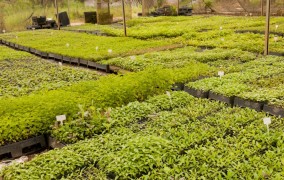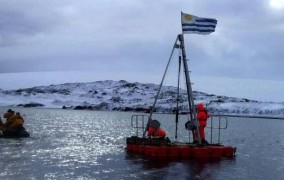
Search: 4362 news
-
Municipal administrators know about NbS but rarely use them to reduce environmental inequality
2023-05-31Study mapped knowledge of nature-based solutions among municipal staff responsible for projects in 20 Brazilian cities. The survey points to the need to adapt the approach used in the northern hemisphere to local conditions. -
Research project analyzes medical, nutritional and environmental applications of new Antarctic bacteria
2023-05-31Discovered by Uruguayan scientists in 2013, two psychrophilic (cold-adapted) species have been experimented with since 2018 by a partnership between IIBCE in Montevideo and the University of São Paulo in Brazil. -
Researchers develop a sweet potato with nearly twice as much beta-carotene as the main commercial variety
2023-05-31Research groups in São Paulo state and Mozambique analyzed carotenoids in over 1,000 sweet potatoes and found some with 88% more beta-carotene, a precursor of vitamin A. -
Rather than being a risk factor, asthma could protect patients from progressing to severe COVID-19
2023-05-31Researchers in São Paulo state analyzed data for over 1 million patients hospitalized for treatment by the public health service after contracting COVID-19. Lower levels of inflammatory cytokines and fewer ACE2 receptors for the virus to bind to may be the explanation. -
Study points out errors in illustrations of one of the most famous scientific experiments
2023-05-24Described by Benjamin Franklin in the mid-eighteenth century, the kite experiment was an important step toward our modern understanding of electricity, but the pictures that popularized this episode are full of inaccuracies. -
In resistance training, focusing on load or number of repetitions leads to same muscle growth
2023-05-24A study by researchers at the State University of Campinas showed that although the two types of training produce similar metabolic stress, muscle activation is different. -
Toxins are detected in samples of curd cheese and artisan mozzarella in Brazil
2023-05-24An analysis conducted at the University of São Paulo showed that no sample exceeded the recommended limit for aflatoxin M1, a contaminant of fungal origin considered carcinogenic. Nevertheless, the researchers warn of the need to demand best practices in dairy production. -
Leishmania parasite manipulates organism’s defense system to continue replicating, study shows
2023-05-24Leishmania alters the structure of the human protein that would normally induce the death of infected cells and weakens the inflammatory response. Reported in Nature Communications, the discovery could serve as a basis for better treatment. -
At the United Nations, FAPESP takes part in a forum on the Sustainable Development Goals
2023-05-24FAPESP has funded more than 40,000 research projects linked to one or more SDGs, said Marco Antonio Zago. -
Study proposes criteria to help delimit and conserve Cerrado wetlands
2023-05-24No fewer than eight important hydrographic basins depend on the ecosystems that make up the Cerrado, Brazil’s savanna-like biome, but ambiguities in the legislation have permitted the advance of soybean plantations in the region. The warning is in an article by Brazilian researchers in the journal Perspectives in Ecology and Conservation. -
Study proves efficacy of remote physical training in rehabilitation of severe COVID patients
2023-05-17A program developed by researchers at the University of São Paulo included three weekly sessions of up to 80 minutes each for 16 weeks, with positive effects on cardiorespiratory fitness, lung function, functional capacity, body composition and persistent symptoms. -
Temperature of solar flares helps understand nature of solar plasma
2023-05-17A new study simulated dozens of solar flares and showed that analysis of the Lyman Continuum spectrum formed by hydrogen ionization and recombination can be used for diagnosis of the solar plasma. -
Novel disinfectant turns into gel on application
2023-05-17A sprayable solution developed by researchers at the State University of Campinas does not spread rapidly over a surface and efficiently eliminates harmful microorganisms. The technology can be licensed from the university’s innovation agency. -
Brazilian researchers test technique that can make analysis of male fertility potential more accurate
2023-05-17Scientists at São Paulo State University repurposed a device already used to analyze bovine reproductive cells to observe different characteristics of human sperm simultaneously. -
Study reveals novel action mechanism of corticosteroids in combating inflammation caused by COVID-19
2023-05-17Brazilian researchers observed an increase in production of endocannabinoid, a natural anti-inflammatory neurotransmitter, in COVID-19 patients given glucocorticoids. The discovery points to possibilities of novel treatments for various inflammatory and neurological diseases. -
Leader of federal agency lists suggestions for revitalization of Brazilian science
2023-05-17Ricardo Galvão, President of the National Council for Scientific and Technological Development (CNPq), discussed the status quo and outlook for Brazilian science in the first of the 2023 FAPESP Lectures. -
Researchers find compound that combats multidrug-resistant bacteria in less than one hour
2023-05-17In vitro experiments were conducted at a FAPESP-supported research center with a synthetic peptide inspired by molecules secreted by the probiotic bacterium Lactobacillus plantarum. -
COVID-19: institutional politics was crucial to success of vaccine technology transfer in Brazil
2023-05-10Researchers show the importance of political skill on the part of federal research institution Fiocruz and regulatory agency ANVISA in the process that resulted in the signature of an agreement with pharmaceutical company AstraZeneca in mid-pandemic. -
Startups selected for Centelha program in São Paulo begin training and capacity building
2023-05-10Representatives of 44 startups will receive 12 months of technical support for the development of products and processes through in-person training, mentoring and workshops run by experts from FAPESP and institutions that promote innovative entrepreneurship. -
Márcio de Castro Silva takes office as Scientific Director of FAPESP
2023-05-10In an interview given to Agência FAPESP, the new director reveals his plans to seek more partnerships with institutions, strengthen the Foundation’s international ties and simplify processes by cutting bureaucracy. -
Study points to novel method for early diagnosis of cachexia in lung cancer patients
2023-05-10Predictive model developed at São Paulo State University (UNESP) helps identify tumor biomarkers of this metabolic syndrome characterized by acute weight loss and muscle wasting. -
Managing the food-water-energy nexus to make cities sustainable
2023-05-10An online event presented the results of five projects selected in a call issued by FAPESP in partnership with the Belmont Forum and JPI Urban Europe. -
Melatonin, commonly used to improve sleep, can aggravate bowel inflammation
2023-05-10In laboratory mice, the hormone easily bought from pharmacies and widely consumed as a supplement aggravated Crohn’s disease and ulcerative colitis, depending on the animal’s gut microbiota profile, according to a study by researchers at the University of São Paulo. -
Used coffee pods can be recycled to produce filaments for 3D printing
2023-05-03Tested by Brazilian and British researchers, the process is an example of circular economy technology, in which waste produced in one economic activity is converted into resources for other sectors. -
FAPESP and Mozambique’s National Research Foundation plan research collaborations
2023-05-03A webinar co-hosted by the two organizations featured researchers from São Paulo and the southeast African country discussing ways to promote scientific collaboration in areas such as climate change, natural disaster monitoring, agriculture, health, and bioenergy. -
German delegation visits FAPESP to strengthen existing agreements and discuss new partnerships
2023-05-03Representatives of German universities, research institutions and funding agencies were welcomed at FAPESP’s headquarters in late March. The Amazon and renewable energy are areas of interest for new bilateral partnerships. -
Biotech startup aims to transform Brazilian biodiversity’s natural products into innovative therapies
2023-05-03A startup based in São Paulo is working with research centers, laboratories and private enterprise to develop novel medications from plant-based natural products. The drugs will be designed to combat multifactorial diseases. -
A method to access genetic information in blood samples and find correlations with mental health problems
2023-05-03In a study with 116 participants, researchers at the Federal University of São Paulo evaluated the genetic material contained in extracellular vesicles possibly secreted by brain tissue. The analysis pointed to patterns of microRNA expression associated with depression, anxiety and ADHD. -
Genetic sequencing of sea turtles can help understand disease that threatens species
2023-05-03The most comprehensive sequencing to date of the genomes of the Leatherback and Green sea turtles shows they are mostly identical. An article in PNAS helps scientists understand how the group has evolved and provides ideas for conservation strategies. -
FAPESP and US National Science Foundation (NSF) announce partnership in all research areas
2023-04-26Agreement simplifies design of new instruments and tools for collaboration between researchers in São Paulo and the United States.
Most popular
-
Amazon scorpion toxin kills breast cancer cells
2025-06-18
-
Spending more than 3 hours a day sedentary worsens teens’ mental health
2025-02-20
-
Climate change could drastically reduce aquifer recharge in Brazil
2025-09-17
-
Microplastics may affect bone health
2025-09-17
-
‘Science alone will not save us’: Paulo Jannuzzi highlights the need for republican values
2025-09-17
-
Butantan Institute says its dengue vaccine protects against serotype 3
2025-02-05
-
FAPESP aims to boost the development of quantum technologies in Brazil
2025-01-15
-
Molecule reverses cognitive deficits associated with aging and dementia in animal tests
2025-05-12
-
Ants defend plants from herbivores but can hinder pollination
2025-09-15
-
Personality traits influence the development of insomnia
2025-05-19


































